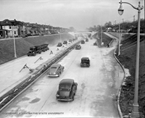
The Automobile Shapes The City
Expressways, Freeways, and Superhighways
Expressways accelerated movement to the urban periphery, especially with superhighways and the construction of the interstate system. The Interstate Highway Act of 1956 committed the nation to a coast-to-coast toll-free system with greater dependence on automobile travel than ever before. The Highway Trust Fund was established to finance the system, drawing revenue from taxes on fuels, truck use, and tire sales that provided a seemingly inexhaustible financial source not subject to regular congressional or executive budgeting. It also undermined any federally-sponsored mass transit programs. The entire interstate network was to be completed by 1971, although it remains unfinished.
The promotion of superhighways and elevated roads, however, predates the 1956 act by several decades. Arguments for introducing urban highways and regional highways initially stressed how such arteries were conducive to economic development and social reorganization. In the same manner that an urban highway might help to revitalize a slum, the regional highways could transform unused land into productive commercial property, whisk people away from the urban cores, and offer only dreamed about housing and recreational opportunities. Such unbridled optimism now seems almost disquieting as relentless sprawl washes over the countryside. Beyond being arteries that connect disparate places, highways make vast urban expansion possible and produce wealth for some, but they also destroy plant life and habitats while creating their own mini-ecosystems. To Lewis Mumford, one of the most noted critics of the automobile, the building of a highway “has about the same result upon vegetation and human structures as the passage of a tornado or the blast of an atom bomb.” Despite Mumford’s hyperbole, road building must overcome many environmental obstacles—landslide threats, drainage problems, unstable soils and alluvial material, rough terrain, sinkholes, and hostile weather conditions—and contributes to many environmental problems—erosion, sediment deposition, water runoff, nonpoint pollution, habitat fragmentation, and habitat barriers. The new roadbeds, by changing how rainfall is dispersed, for example, can also create a ribbon of plant life along the edge of the pavement different from plants several feet away. The new plant cultures as well as the shoulders of roads and other roadside construction may provide shelter for animals, but much closer to roads than is probably safe for them. All of this suggests the monumental impact—environmental, cultural, and economic—that the staggering outward thrust of cities has produced over the years.
<<Previous Section - Next Section>>
Introduction
The “Footprint” of the Automobile on the American City
From “Walking Cities” to “Automobile Cities"
Filling Stations and Other Services
Expressways, Freeways, and Superhighways
Complete Text Printable View
About the Project | Credits | Contact Us | Student & Teacher Resources | Site Map
©2004-2010 Automobile in American Life and Society
